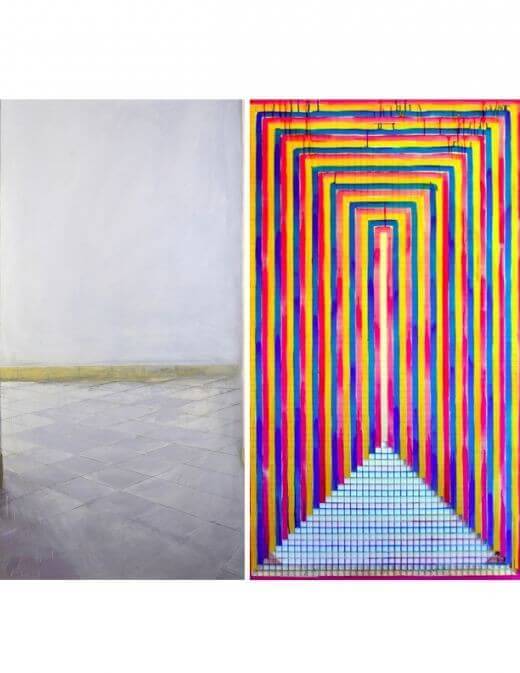- Autumn Casey, Agalma

- Mary Reid Kelley with Patrick Kelley, Sadie, the Saddest Sadist and You Make me Iliad
Binary // Binario: Ernesto García Sánchez & José Manuel Mesías
Kara Pickman

Left: José Manuel Mesías, The room before heaven, 2010 (detail). Acrylic, tempera, pastel, pencil, and marker on canvas, 80 x 56 in. Right: Ernesto García Sánchez, Untitled (from Paintings that are born dead), 2013 (detail). Acrylic on cutout canvas, 78 x 44
January 8–22, 2015
Organized by Rafael Domenech, Havana-born artist and curator, Binary // Binario features two young artists from Domenech’s alma mater, Havana’s Academia Nacional de Bellas Artes San Alejandro. Ernesto García Sánchez and José Manuel Mesías—both painters—approach their medium in divergent ways: Mesías draws largely on the unique visual quality of an aesthetic rooted in Cuba’s history and its cultural evolution, while Sánchez’s works fall in line with a long tradition of paintings that emphasize the medium itself, revealing the inner workings of the support via delicate cutaways in the canvas.
Mesías’s more traditional method acts as a cultural record that is recontextualized to perhaps reflect more contemporary anxieties. A large work, The room before heaven (2010), is soft in palette but claustrophobic on close consideration and illustrates the artist’s view that his work depicts the beauty in the “deterioration of the urban setting as it transmits the anxiety and marvel that the world, in equal parts, provokes.” The world of that statement could be Cuba, or, reflecting greater measures of anxiety and, in particular, marvel—or scrutiny—could indicate the larger outside world looking in.
Sánchez’s largest work on view, Untitled (from the series Paintings that are Born Dead, 2013) at the gallery’s opposite corner, features a brightly colored grid formation disrupted by errant drip marks and his signature subtractive cutaway grid, which plays on the negative space of the white wall behind the painting as well as the materiality of its exposed wooden stretcher. He is clearly interested in the painting beyond its traditional plane, making use of its very framework, pushing the utility of the canvas to its very limit. A familiar word comes up again in his description of the act of painting: “Is [it not] a celebration of the present, an affirmation of being alive? May it not also be a way to rediscover the world?”
While Mesías and Sanchez’s respective illustrative and spare approaches play toward their contrasting qualities in this exhibition, the works also converge in a shared tonality at once bright and tempered, and in the artists’ conscious quality of communicating a worldview to an expanding world.









